LED Sector in Taiwan Has Evolved into One-stop Shop
2009/01/13 | By Ken LiuOver the past few years, Taiwanese LED manufacturers, from chipmakers and packagers to lighting-module and lamp makers, are beginning to see a payoff from the roll out of brighter and more energy efficient products.
Taiwan has rapidly ascended to the number two spot in the global LED supplier ranking, with 2008 revenue estimated to reach around US$1.9 billion, or 26% of world's total.
This record owes to decades-long cultivation of the LED industry in Taiwan, starting with LED packaging operations in the 1970s. Since then the local industry has fleshed out to encompass epitaxy-wafer manufacturing, chip making, and thermal-module manufacturing. As the sector evolves into a one-stop shop for LED products, manufacturers are pushing the envelope on technological innovation.
Beaming
Founded in 2004, LED packaging startup Lustrous Technology Ltd. claims its chip-on-board (COB) packaging technology pares chip junction temperature to less than two degrees centigrade per watt. "We use the technology on high-power LED emitters driven by current over 300mA," reports company sales vice president, Jim Tsao.
Tsao stresses that COB has recently emerged as the packaging technology of choice due to its superior thermal and cost efficiencies and streamlined thermal-management design relative to existing technologies. "This is an ideal packaging solution that meets the needs of the lighting market," he says.
Lustrous has been developing COB packaging technology since it was founded in 2004. The company directly mounts packaged devices on an aluminum substrate, which helps reduce thermal resistance. "The technology brings total junction temperature on our LED module to under 80 degrees centigrade," Tsao notes.
Tsao's company has introduced one-watt, three-watt, five-watt and 10-watt emitters built around the technology. Its 10-watt emitter, embedded with nine chips, now delivers 1,000 lumens in brightness output. The company churns out about 30,000 to 50,000 units per month.
Tsao claims that emitters using the COB packaging technology can operate at full luminosity for 50,000 hours before a 30% decay sets in. "We have over 20 patents doe the COB technology in the United States, Japan and Taiwan," he says.
To avert disputes over chip intellectual property, the company builds Epistar Inc.'s chips into emitters for domestic sales and Cree Inc.'s chips into products for exports. Epistar is Taiwan's No.1 LED-chip maker.
Tsao says that his company's R&D team brings together considerable talent in thermal-dissipation and optoelectronics. "We can provide lighting manufacturers with tailor-made solutions. In many cases, we develop emitters in cooperation with end-product manufacturers and retailers," he notes. For instance, Lustrous has introduced a 3W, 750-lumen LED compact lamp in cooperation with Topco Technologies Corp. The lamp is now available at NT$1,280 (US$40) in Taiwan at the Tsann Kuen electronics retail chain.
Topco and Neng Tyi Co., Ltd., two major shareholders of Lustrous, are the primary sources of the packager's strength. Topco develops end products for the emitters and handles marketing, while Neng Tyi, which makes thermal devices for IT products, provide thermal modules.
Tsao stresses that with self-sufficient technologies the company "does not have patent problem and is two to three years ahead of rivals in terms of R&D pace because we've mastered package-structure, phosphor, and chip know-how."
Major applications for the company's emitters include MR16, sunken lamps, down lights, wash wall lamps, and streetlights. "There are too many types of lighting fixtures and it's very hard for us to fill each of their needs. But, we have formed a field application engineer team in cooperation with subcontracted suppliers to help lighting-fixture manufacturers solve problems related to thermal, electrical power and optics when making LED lighting products," Tsao says.
Tsao points out that high cost remains the major hurdle keeping LED from becoming a mainstream illumination source today. Comparing a 13W LED lamp with a compact fluorescent lamp in same power specification, Liu notes the LED lamp is priced eight times above the fluorescent lamp. However, he estimates Taiwanese LED-lighting manufacturers can pare that multiple to just three- to five-fold in two years by trimming production costs.
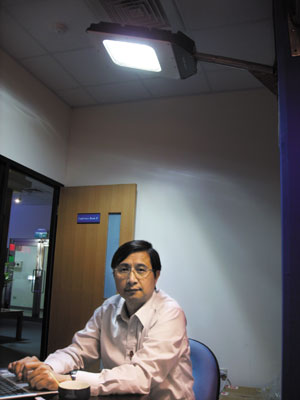
All Together Now
NeoPac Lighting Inc.'s NeoBulb Light Engine, a high-power LED lighting module comprising an emitter and a thermal module, has made a splash since it was debuted in 2005. The attention owes largely to its system-in-a-packaging technology and heat-pipe thermal module. According to the company's president and chief executive officer, Jeffery Chen, the whole module's junction temperature is less than 60 degrees centigrade and ambient temperature maintains at about 25 degrees.
"Good thermal dissipation gives our 60-lumen-watt NeoPac emitter a service life of over 60,000 hours and reduces emitter failure to just 0.6 out of every 1,000 units after 61,000 hours of non-stop service," Chen reports. To back this figure, Chen says his company kept an emitter in a microwave set at 85 degrees centigrade for a whole month. "When we took it out, it still worked normally," Chen recalls. His company assures a defect ratio on its emitters of under 560 PPM (particle per million).
The company has registered over 50 patents for its outstanding packaging and thermal technologies.
Thanks to its highly effective heat-dissipation technologies, NeoPac can mount a cluster of high-power chips on one emitter module. The company is also improving the efficacy of its LED lighting products. For instance, the company is working to boost the efficiency of its 135W streetlight, equipped with 18 NeoBulb lamps, to 75 lumens per watt from 37 lumens. The first version of this light has total output of 5,000 lumens, which the company claims is the best performance in the industry for general lighting purposes. The improvement will double the light's illumination output.
"By doing that," Chen stresses, "we will break the Haitz Law and boost total lumens without any restriction." The Haitz Law was established by Roland Haitz, a scientist now retired from Agilent Technology, who predicted in 2003 that based on the previous record-a doubling of illumination every 18 to 24 months-the lumens of a single LED would increase 20 folds while the price of the diode would fall to one-tenth of the 2003 level by 2013.
Impressed by the company's reliable quality, governments of Guangdong, Beijing, Shenyang and Shanghai have installed NeoPac's 1270-lumen streetlights on some of the main roads in those regions. "We have landed orders from 88 countries including mainland China, South Korea, Germany, Japan, the United States, Latin American nations and Taiwan," Chen reports.
In Taiwan, the company's lamps are installed at the buildings of the Ministry of Economic Affairs building, Ministry of Foreign Affairs, National Central University, McDonald's, Starbucks, National Museum of Natural Science, and a well known Taoism temple in Taipei City.
After introducing unique LED lighting modules, the company has a more ambitious plan-running its own lighting business. "We've opened the business to promote our NeoBulb lamps by installing the lamps on the lighting fixtures it sells. With the new business, we can demonstrate to the market the various applications of our bulbs," Chen stresses. "You need concrete products to show people how your core technology can be applied," Chen says, describing his company as the "Intel of LED lighting industry."
Among the application that the company is pushing for its thermal products is lighting-fixtures, solar cells and CPUs.
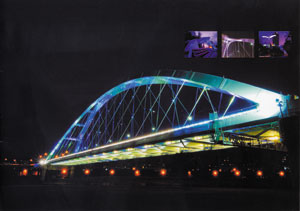
Cool Packaging
Everlight Electronics Co., Ltd., Taiwan's No.1 LED packager, has recently introduced a number of edge products including a ceramic packaging technology and a family of high-power emitters.
The ceramic packaging technology features low thermal resistance and compliance with RoHS standards, making it suitable for high-power chips. According to the assistant chief of the company's LBU Sales Dept., Eric Lu, the material generates resistance of only 15K/W. "With this material, we have shrunk the emitter size by a third, making high-power emitters more light and suitable for various lighting applications," he notes.
The technology has been used on emitters for backlight modules, automobile lamps, architectural indoor and outdoor lights, signage boards, and commercial lights.
The company's EHP-L02N emitters boast junction-to-sink temperature of only three degrees centigrade per watt. The emitters come in warm-white and white types, with the former giving off luminous flux of 500lm and the latter 560lm. The emitters have been built into 20W and 25W streetlights. The 20W light generates 1,100 lumens at 1.8 ampere and the 25W light gives off 1,300 lumens at 2.2A.
With some unique packaging technology, the company's EHP AX08 family of single-chip 10W emitters boasts efficiency of over 80lm per watt at 350mA. Thermal resistance is blow 15 degrees centigrade per watt.
"In addition to ceramic, we also use aluminum as packaging substrate. Both are good thermal-conductivity materials," Eros Lu, a sales engineer of the company's Taiwan sales department, says.
To illustrate the power of its emitters, the company is demonstrating its Dolphin SL family of LED streetlights, which are equipped with its emitters. The 120W streetlights give off around 90-100 lumens per watt at 100-240 voltage and boast a power factor higher than 99%. "We guarantee a 20,000-hour life span for the light," Lu says. The streetlight has passed the IP65 test for waterproof and dust-proof quality.
Eric Lu says that orders for the company's lighting emitters are growing, helped by competitive pricing. He concedes that the lights using his company's emitters are still pricier than traditional lamps, but notes that LEDs are more durable. "If more people buy LED lamps, prices will fall more quickly," he says.
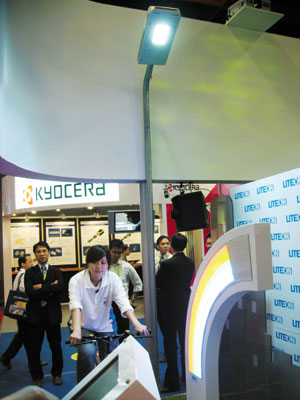
Lights On
Lite-On Technology Corp., Taiwan's first LED packager founded in 1975, has introduced a wide range of high-power emitters for lighting applications. Its 0.5W emitter is used in the light bars of refrigerators, and its 1W, 3W and 5W emitters have gone into streetlights, residential lights, signage boards and commercial lights. Its high-power emitters deliver efficiency of over 90lm per watt.
A specialist in surface mount technology (SMT) and chip-on-board (COB) packaging for single-chip and multi-chip emitters, Lite-On has licensed a patented SMT technology and a patented phosphor conversion technology from Osram.
According to the company's general manager for Advanced Lighting Solution SBU, Dr. Rex Wu, Lite-On is branching into other energy-saving lighting sectors based on its self-sufficient technology and through strategic alliances. "For instance, Lite-On IT [a storage-media affiliate of Lite-On Technology] has entered production of energy-saving lamps and begun developing a presence in the solar-energy sector," he notes.
Also, the company is reportedly venturing into LED-chip manufacturing by investing US$10 million in SemiLEDs Corp of the United States, a manufacturer of high-power LED chips.
Last year, the company acquired Leotek Electronics Corp. of Taiwan, the No.2 supplier of LED traffic lights used in the United States. Leotek now builds Lite-On's emitters into its traffic lights.
Some unique designs like glaring-proof lens are embedded in the company's emitters. To demonstrate the quality of its LED lamps, the company has installed streetlights using its high-power emitters at its factory in Guangzhou of mainland China.
Impressed by the growing wakeup to global trend of energy saving, Wu is bullish about the market future of LED lighting. "We believe 150 lumen-watt technology will be commercially available next year," he estimates.
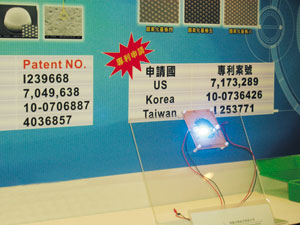
Alternative Lighting
Formosa Epitaxy Inc., a leading LED wafer and chip maker on the island, has recently entered the industry spotlight with several patented technologies, most notably an alternative-current (AC) LED chip and photonic crystal technology for green chips.
The AC LED chip was developed by itself. "What makes AC technology so attractive to the industry is its superior ability, compared to DC [direct current] technology, to boost the power efficiency of a lamp," stresses Alex Ho, an assistant manager at the company's sales division.
Ho says that since AC is the household mainstay, an AC chip eliminates the need for current stabilizers like converters or transformers. "The AC-DC conversion is usually the main causes of power loss in lighting devices," he says.
Ho concedes, however, that AC tends to become unstable when electrical voltage fluctuates. "We've installed circuits on the chip to stabilize the current through it," Ho says. The company has built the chip into 1W LED emitters and is working on higher-power applications.
By sidestepping the converter, AC emitters can reduce the cost of LED lighting over the long term, though real gains will require high enough volume to make the technology more affordable, says Ho. The technology is protected by patents in the United States, South Korea and Taiwan.
Photonic-crystal technology is reported to make Formosa's green chips the brightest of their kind. Its 150mA chip boosts performance to 80 lumens per watt and 350mA chips deliver 120 lumen per watt after packaging. "These results represent a 50% increase from previous performances," Ho says.
Ho notes that green chips are particularly important in white LED lamps joining red, green and blue chips. "Red, green and blue chips contribute brightness at a ratio of 3:6:1," Ho notes.
According to Ho, Formosa is on track to boost its white LED's efficiency to 120 lumen per watt in the fourth quarter next year from 80 lumen per watt achieved in the third quarter this year.
Founded in 1999, Formosa has been dedicated to production of high-brightness InGaN-based LED wafers and chips. The company claims it is the only Taiwanese LED chipmaker supplying a full spectrum of chips, including blue, green and near-ultraviolet chips. It is also the sole LED chipmaker in Taiwan to license a unique high-power technology from Cree of the United States.
The company has proven the excellent quality of its chips in several types of lighting fixture. A 120W LED streetlight lighting module the company developed in cooperation with its customer has a life-span of over 50,000 hours, luminous efficiency of 45lumen/watt, and ambient temperature under 50 degrees centigrade.
High-power chips have increased to account for 20% of the company's revenue from 15% in the first quarter this year helped by orders from China streetlight applications and domestic demand for wash wall lamp chips. To keep up with growing demand, the company plans in the first quarter next year to add 15 metal organic chemical vapor deposition (MOCVD) machines to its current 20, lifting capacity from 330 million chips to 650-700 million chips.
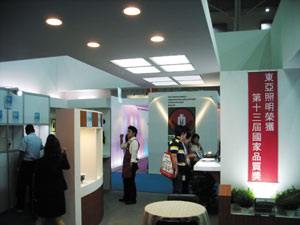
Heavyweight
Turning out about four million fluorescent tubes a month, China Electric Mfg. Corp. commands the number one spot in Taiwan's lamp industry. The company is also increasing its presence in the LED lighting sector with the introduction of LED linear lights, table lamps, E27 lamps, recessed lights, MR16 lights, pendent lamps, bollard lights, spot lights, and wall lamps.
"Compared with several years ago, we're more confident now of promoting LED lamps because we have fuller range of products to offer and our products are more reliable," says Allan Huang, director of China Electric's international business division. Huang also notes that LED lights have fallen in price and improved in illumination and life span over the past few years.
One of the company's top LED products is a downlight equipped with Cree's high-power LED chips and modules. The lamp has a color rendering index of 92 and puts out 650 lumens of brightness.
Apart from its broad product line, China Electric has an edge in production as well. It has its own packaging plant and owns a major stake in packager Wellypower Optronics Corp. "We use flip-chip packaging due to its excellent thermal dissipation," Huang says.
Huang says that his company has been targeting its LED lamps at public work projects and premises. Several years ago, the company won a bid to equip the National Science Council's Technology Building with LED lamps.
Huang says that LED lamps account for 10% of China Electric's revenue and should keep growing. "LED will replace some light sources, but the replacement pace will be determined mostly by price, quality and durability," he says.
As a heavyweight of the island's lighting industry, China Electric was invited by the Ministry of Economic Affairs last year to organize an alliance to set industry standard for LED lighting and develop LED technologies. E.P. Tsai, a former China Electric general manger, noted that the alliance would team up with the government-backed ITRI and other local manufacturers to introduce LED streetlights, LED spotlights and LED grid-structure lighting fixtures that are comparable to traditional products in two years.

